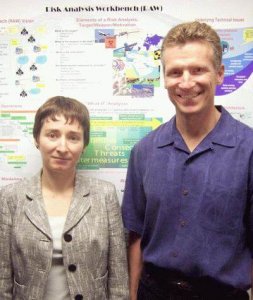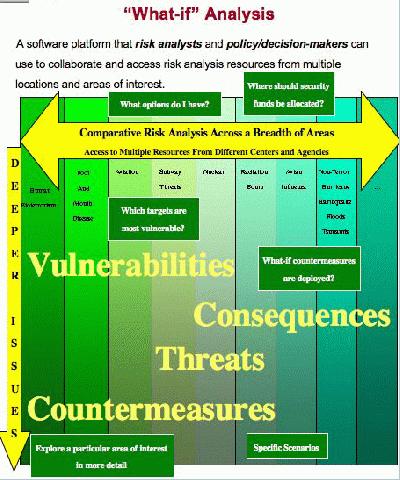
Tatiana Kichkaylo, left, and RAW project leader Michael Orosz
An ISI team working under the auspices of the Department of Homeland Security-funded Center for Risk and Economic Analysis of Terrorism Events (CREATE) is creating a system that will speed and help make more consistent the difficult task of quantifying risk estimates to guide policymakers.
Information Sciences Institute project leader Michael Orosz is leading the team working on the tool, called Risk Analysis Workbench, or RAW, which will ultimately be used at all eight DHS research centers, not just CREATE, which is located at the University of Southern California. ISI is part of the USC Viterbi School of Engineering, which also is co-host of CREATE.The project brings together longstanding ISI strengths in web resources, information sharing and artificial intelligence to the task of gathering and distributing the specific data necessary to perform the tree analyses and other problems of “what-if” risk analysis in a speedy and — above all — in a uniform way.
ISI insights and inventions around the “semantic web,” — systematic structuring of database information to make it more accessible over the Internet — are a major part of the system, which is also incorporating efforts by ISI’s Robert Neches and Tatiana Kichkaylo.
 RAW grows directly out of work by CREATE director Detlof von Winterfeldt, a professor in the Viterbi School department of industrial and systems engineering with a distinguished career stretching back decades in the field of risk assessment.
RAW grows directly out of work by CREATE director Detlof von Winterfeldt, a professor in the Viterbi School department of industrial and systems engineering with a distinguished career stretching back decades in the field of risk assessment.
In an interview, Von Winterfeldt illustrated the way that the analysis proceeds by pointing to a specific CREATE study he himself completed, about the dangers posed by a small, man-portable anti- aircraft rockets being used to bring down a passenger airline, tracking consequences out a “decision trees” of alternate possibilities to evaluate costs and benefits.
The estimate for the cost of installing countermeasures, Winterfeldt says, is about $30 billion for the air fleet, which at first sight seemed completely out of line with the damage that an attack would cause. But tracking out the decision trees, more and more costs appeared growing out of a successful attack, widening impacts.
The bottom line of the study was that the installation of the defenses would be cost effective if three conditions prevail: 1) the probability of a MANPADS attack is greater than 40 percent over 10 years; 2) the economic losses are very large (greater than $75 billion); and 3) the countermeasures are relatively inexpensive (less than $15 billion) to implement.
This analysis by Von Winterfeldt was a widely admired achievement of CREATE’s first years – but the intensity of effort required to reach the conclusions raised an obvious question. Risk assessments have historically been what the British call “one-off” cases &ndash isolated single efforts attacking a single problem.
But the wide needs of Homeland Security in many areas for parallel products has led to the RAW effort, an integrated, generalized toolbox designed to be used by risk analysts all over the nation, at all the centers, in a standardized but flexible format.
RAW is still in development. The current version is RAW 2.0, which according to Orosz will be distributed in July an ‘alpha’ or research version, rather than a “beta” – ready for trial use in the field. As an example problem, the ISI team is now working to integrate into RAW risk analysis resources used in foot and mouth disease research being undertaken at one of the other centers, the Center for Foreign Animal and Zoonotic Disease Defense, (FAZD), located in Texas, and will be reaching out to the other 6 centers for subject matter.
The system, says Orosz, “it is designed so that you don’t have to be a computer scientist to use it.”
Orosz hopes to distribute a beta version of RAW later this year.
Published on May 29th, 2007
Last updated on August 6th, 2021













